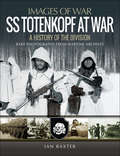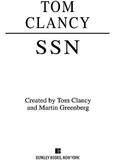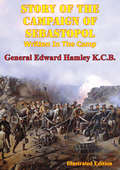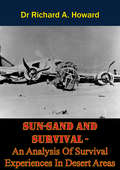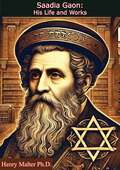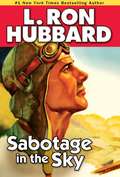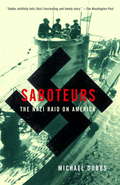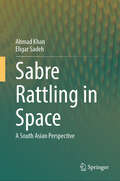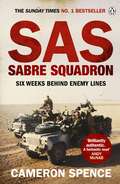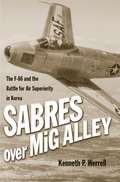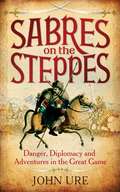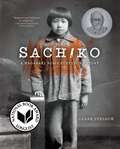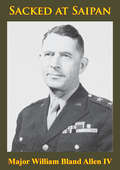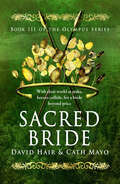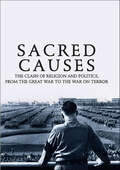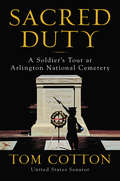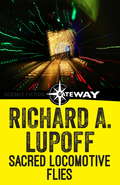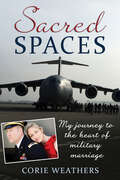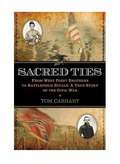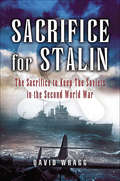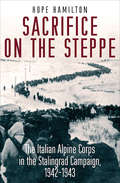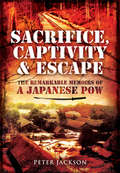- Table View
- List View
SS Totenkopf at War: A History of the Division (Images of War)
by Ian BaxterThe SS Totenkopf (Death Head) Division even 70 years on retains its formidable and ruthless reputation as a superbly efficient yet murderous formation. It earned this for its actions throughout the Second World War, first in 1940 during the blitzkrieg in Northern France and then on the Eastern Front. The battles at Kharkov and Kurst saw some of the fiercest fighting of that long and terrible campaign. During the long retreat back to the Fatherland the Division fought with customary dogged determination, nay fanaticism. This superbly illustrated work, drawing on images taken by participants, portrays the SS Totenkopfs history from formation through training to the battles in northern France and in Russia.
SSN: A Strategy Guide to Submarine Warfare
by Tom ClancyThe "forgotten Clancy novel," SSN is a complete submarine warfare novel with maps, photos, and a special interview with Tom Clancy and former submarine commander Doug Littlejohns.<P> China has invaded the oil-rich Spratly Islands. The American response has been swift and deadly, resulting in the start of World War III. SSN: Strategies of Submarine Warfare presents 15 thrilling scenarios--fact-based mission profiles for Captain Bartholomew Mackenzie and the crew of the nuclear submarine the U.S.S. Cheyenne--stirring plots and characters, perfectly accurate details, and the chilling knowledge that these events could really happen.
STORY OF THE CAMPAIGN OF SEBASTOPOL: Written In The Camp [Illustrated Edition]
by Lieutenant-General Sir Edward Bruce Hamley KCB KCMG[Illustrated with over two hundred and sixty maps, photos and portraits, of the battles, individuals and places involved in the Crimean War]"Eyewitness account of the fighting during the Crimean War."While I was delivering the order, a round shot passed through my horse, close to the saddle, and rolled us over; while on the ground another canon shot passed through him. A sergeant of artillery ran to extricate me; he had just lifted from under the horse, and I was in the act of steadying myself on his shoulder, when a shot carried off his thigh and he fell back on me....This is a scene describes a narrow escape for Hamley during the bloody battle of Inkerman. The author of this remarkable book, a Gunner officer, served on the Artillery Staff, first as Adjutant to the First Division field artillery and then as ADC to the Commander Royal Artillery throughout the siege of Sevastopol, and as such he was well placed to make this record of the campaign. As he says in the introduction it was not his intention to indulge in fanciful rhetoric but to give a 'round, unvarnished tale.' All was written in camp when he was off duty, in a tent or in a hut, and his descriptions of the fighting and the aftermath paint a grim and often gruesome picture. Disease and sickness ravaged the army; in Dec. 1854 and Jan. 1855 the sick returns amounted to 14,000. The pictures he paints, in his matter-of-fact narrative, reflect some appalling sights of the dead and dying on the battlefields. He takes us through the Alma, Inkerman, Balaklava to the fall of Sevastopol in Sep. 1855 which was the prelude to the peace talks a few months later. The siege of Sevastopol lasted a year and cost the British some 11,000 casualties, the French 12,000 and the Russians 50,000. There are some very good illustrations by the author himself. For the students of this dreadfully mishandled war (administration, logistics and medical) this book will be compulsive reading."-Print Ed.
SUN-SAND AND SURVIVAL - An Analysis Of Survival Experiences In Desert Areas
by Dr Richard A. HowardDesert survival presents unique problems not met in other non-temperate areas. Recognizing this, the Arctic, Desert, Tropic Information Center commissioned Dr. Richard A. Howard to assemble and analyze desert survival experiences of World War II, for the purpose of increasing our knowledge of desert survival techniques and procedures. To know what World War II survivors did, what they thought, and what they recommended after having experienced desert survival conditions is of paramount importance. Sun, Sand and Survival relates and evaluates these experiences.Dr. Howard, ADTIC consultant, has had long experience in the survival training of military personnel. He is the author of the ADTIC Publication T-100 999 Survived which analyzes 1,000 tropical survival experiences. Dr. Howard's desert study analyzes 382 successful desert survival episodes and mention is made of an additional 142 individuals who were lost. The stories show how men without desert background or mental conditioning met their desert problems. They include examples of men who left their group and were never heard of again. In the light of our present knowledge of the water requirements of the human body, we know that many could have survived had they had a better understanding of the requirements imposed by the desert. More survivors would have returned in better health and endured less discomfort if advance knowledge had been readily available.
Saadia Gaon: His Life and Works
by Henry MalterUncover the remarkable legacy of one of Judaism's most influential figures with Henry Malter's comprehensive biography, "Saadia Gaon: His Life and Works." This meticulously researched book offers an in-depth look at the life, philosophy, and enduring contributions of Saadia Gaon, a towering intellect of the medieval Jewish world.Henry Malter, a distinguished scholar of Jewish history and literature, delves into the multifaceted achievements of Saadia Gaon, who lived during the 9th and 10th centuries. Known for his exceptional scholarship, Saadia was a philosopher, exegete, and community leader whose work laid the foundations for much of Jewish thought and practice."Saadia Gaon: His Life and Works" explores Saadia's early years in Egypt, his rise to prominence as the head of the Sura Academy in Babylon, and his prolific contributions to Jewish scholarship. Malter provides a detailed account of Saadia's major works, including his influential translation and commentary on the Hebrew Bible, his philosophical treatise "The Book of Beliefs and Opinions," and his writings on Hebrew grammar and poetry.Through rich historical context and insightful analysis, Malter highlights Saadia's role in defending Rabbinic Judaism against the Karaites, a Jewish sect that rejected the Oral Torah. Saadia's rational approach to faith, his commitment to integrating Jewish tradition with contemporary philosophy, and his efforts to make Jewish texts accessible to a broader audience are all examined in depth.This biography also sheds light on Saadia's personal struggles and his unwavering dedication to his community. Malter's portrayal of Saadia Gaon is both scholarly and accessible, making complex theological and philosophical concepts understandable to a wide readership."Saadia Gaon: His Life and Works" is an essential read for students of Jewish history, theology, and philosophy. Henry Malter's authoritative and engaging narrative ensures that the legacy of Saadia Gaon is both preserved and appreciated, offering readers a profound understanding of his enduring impact on Jewish thought.
Saarbrück to Paris, 1870: A Strategical Sketch (Special Campaigns Series #1)
by Lt. Colonel Sisson C. PrattThe Franco-War of 1870 marked an absolute watershed: France had been the military and cultural centre-point of mainland Europe for some centuries, its fashion copied, its armies feared and its language the language of diplomacy and the highest circles. Growing in power, prestige and ambition, the states of Germany stood in opposition to this hegemony, a newborn power with much to prove. Its dominant driving force was Prussia, under the determined statesman Bismarck. The French goaded the Germans into action, provoking war. The Germans had been preparing for the conflict for some years and sprung into action, and the ensuing action would be a debacle for the French and a might victory for the Germans.This book is part of the Special Campaigns series produced around the turn of the 20th century by serving or recently retired British and Indian Army officers. They were intended principally for use by British officers seeking a wider knowledge of military history.Author -- Lt.-Colonel Sisson C. Pratt (Late R.E.) (1844-1919)Text taken, whole and complete, from the edition published in 1907, London and New York, by Swan Sonneshein & Co. Ltd.Original Page Count - vii and 209 pages.Illustrations - The original maps cannot be provided with this edition due to their A3 size.
Sabotage in the Sky
by L. Ron HubbardLaunch into the action with this triumphant tale! Pilot Terry Lee has taught Bill Trevillian everything he knows about flying, enough that Bill's know considered the ace of American test pilots just as war breaks out in World War II Europe. Unknown to Bill, Terry's also taught his own kid sister, Kip, who's now almost as good a pilot as Bill and quite the looker to boot. When France and Great Britain must choose between different American plane designs to outfly the newest and deadliest Nazi fighters, the competing companies send their two best test pilots . . . Kip and Bill. Unfortunately, a spy also has been sent to infiltrate and sabotage the planes to make sure that neither the French nor British will consider them safe enough to fly. Soon Kip and Bill suspect the other of sabotage-- a problem that not only threatens their already electric relationship but their very lives. "Riveting cliff-hanger action." --Midwest Book Review
Saboteurs: The Nazi Raid on America
by Michael DobbsShortly after America's entry into World War II, Adolf Hitler ordered an extensive sabotage campaign against the United States to disrupt the production of tanks and airplanes and blow up bridges and railroads. Eight German saboteurs were dispatched across the Atlantic by U-boat, one team landing in Amagansett, Long Island, the other near Jacksonville, Florida. They brought with them enough money and explosives for a two-year operation and traveled inland to explore potential targets. The full story of this audacious endeavor is a remarkable account of a terrorist threat against America. Michael Dobbs describes the saboteurs' training in Nazi Germany, their claustrophobic three-week voyage in submarines, and their infiltration into American life. He explores the reasons each volunteered, and their links to a network of Nazi sympathizers in the United States. He paints a portrait of the group's leaders:George Dasch, a onetime waiter who dreamed of leaving his personal mark on history, and Edward Kerling, a fanatic Nazi caught between his love for his mistress and his love for his wife. And he shows how the FBI might never have captured the saboteurs had one of them not helped J. Edgar Hoover transform a hapless manhunt into one of his proudest accomplishments. A military tribunal, a historic Supreme Court session, and one of the largest mass executions in American history provide a stunning climax to a dangerous but failed mission.
Sabre Rattling in Space: A South Asian Perspective
by Ahmad Khan Eligar SadehThis book offers historical and theoretical context of the path followed by States, from space militarization to weaponization, and deconstructs traditional security paradigm myths to prove that a paradigm shift has been brought because of deadly space weapons developed by major space powers. It reconciles that the strategic distrust between two leading space competitors, U.S. and China, has prompted them to pursue counter-space capabilities. The ripple effect of this troubling relation in space is not limited at the global level, but has witnessed a trickledown effect on regional security. In relation to this, the book offers details of the Indian space program including its military space ambitions, and provides information about Pakistan’s objectives in space. It offers an overview of challenges to international space governance and how the structural flaws help states to aggressively follow a path toward space weaponization. Additionally, it discusses the UN negotiating arms control measures in space and the politics of states not to negotiate prevention of an arms race in outer space. The book is a useful contribution to space security, from both traditional and contemporary approaches, covering history, theory, and application. It provides an academic as well as practical approach carrying appeal for professionals, experts, opinion makers, industry, academics, teachers, policy makers, politicians and masses from other walks of life who are interests in space security.
Sabre Squadron
by Cameron SpenceWith the outbreak of Gulf War hostilities a unit from 22 SAS slipped quietly over the border and into the enemy's backyard. It would be six weeks before any of the patrol again reached safety.Sabre Squadron recounts in graphic detail their scud-busting operations deep inside Iraq. They were operating alone and out of reach of reinforcements, with the threat of detection and its fatal consequences ever present. Yet their determination to wreak havoc behind enemy lines remained undimmed, culminating in an attack that decisively reconfirmed the regiment's awesome reputation.Cameron Spence, a senior NCO on the operation, takes you as close to the fighting SAS as you are ever likely to get, conveying the relentless tension, black humour and camaraderie punctuated by explosive, nerve-shredding action that characterized the mission.This is the true story of an SAS operation of breathtaking audacity and flair, carried out under unimaginable pressure, in the face of impossible odds._____________'A brilliantly authentic account of war with an SAS patrol, it's a fantastic read' - ANDY MCNAB, bestselling author of Bravo Two Zero'Tense and at times terrifying... a well told action story' - SUNDAY TELEGRAPH'A terrific read' - THE TIMES'Blood, guts and military macho - as authentic as anything you are likely to read' - MAIL ON SUNDAY
Sabres Over MiG Alley
by Kenneth P. WerrellThis is the story of the first jet versus jet war, the largest in number of victories and losses, and one of the few military bright spots in the Korean War. It tells how an outnumbered force of F-86 Sabres limited by range and restricted by the rules of engagement, decisively defeated its foe. Based on the latest scholarship, author Kenneth Werrell uses previously untapped sources and interviews with sixty former F-86 pilots to explore new aspects of the subject and shed light on controversies previously neglected. For example, he found much greater violation of the Yalu River than thus far has appeared in the published materials. The F-86 became a legend in "The Forgotten War" because of its performance and beauty, but most of all, because of its record in combat.
Sabres on the Steppes: Danger, Diplomacy and Adventure in the Great Game
by Sir John UreBack in the day when men were men and Britain ruled the world, the two great world powers went head to head over control of central Asia - from the Caucasus to Kabul. This was the stage of open warfare but also espionage, subterfuge and reckless adventure. Following on from the derring do of Shooting Leave, John Ure tells the story of British soldiers, missionaries and mercenaries, horse traders and opportunists who travelled to make their name in the Great Game.Praise for Shooting Leave:'Extremely entertaining ... deserves to be a surprise Christmas bestseller.' Robert Harris.'Gripping stuff.' Peter Hopkirk.'Anyone with red blood in his or her veins will be stirred by these stories ... The perfect read.' Country Life.
Sabres on the Steppes: Danger, Diplomacy and Adventures in the Great Game
by John UreBack in the day when men were men and Britain ruled the world, the two great world powers went head to head over control of central Asia - from the Caucasus to Kabul. This was the stage of open warfare but also espionage, subterfuge and reckless adventure. Following on from the derring do of Shooting Leave, John Ure tells the story of British soldiers, missionaries and mercenaries, horse traders and opportunists who travelled to make their name in the Great Game.
Sachiko: A Novel (Weatherhead Books on Asia)
by Shūsaku EndōIn novels such as Silence, Endō Shūsaku examined the persecution of Japanese Christians in different historical eras. Sachiko, set in Nagasaki in the painful years between 1930 and 1945, is the story of two young people trying to find love during yet another period in which Japanese Christians were accused of disloyalty to their country.In the 1930s, two young Japanese Christians, Sachiko and Shūhei, are free to play with American children in their neighborhood. But life becomes increasingly difficult for them and other Christians after Japan launches wars of aggression. Meanwhile, a Polish Franciscan priest and former missionary in Nagasaki, Father Maximillian Kolbe, is arrested after returning to his homeland. Endō alternates scenes between Nagasaki—where the growing love between Sachiko and Shūhei is imperiled by mounting persecution—and Auschwitz, where the priest has been sent. Shūhei’s dilemma deepens when he faces conscription into the Japanese military, conflicting with the Christian belief that killing is a sin. With the A-bomb attack on Nagasaki looming in the distance, Endō depicts ordinary people trying to live lives of faith in a wartime situation that renders daily life increasingly unbearable. Endō’s compassion for his characters, reflecting their struggles to find and share love for others, makes Sachiko one of his most moving novels.
Sacked At Saipan
by Major William Bland Allen IVThe relief of Major General Ralph Smith, U.S. Army, from the command of the 27th Infantry Division during the battle for Saipan on 24 June 1944 by Lieutenant General Holland M. Smith, U.S. Marine Corps, seemingly ignited a slow-burning fuse of service competition, jealousy, and animosity that some say is still burning bright today...Nearly seventy years later, the question is still a topic of debate. Was Lieutenant General Holland Smith justified in relieving Major General Ralph Smith? Holland Smith's justifications centered on Ralph Smith's apparent disregard of orders and perceived inability to lead his division in combat. Historical appraisals of this relief have most often focused on either Army or Marine Corps doctrines in place at the time of the battle for Saipan. Instead of comparing and contrasting doctrines from the Second World War, this monograph appraises Lieutenant General Holland Smith's effectiveness as a corps level commander and the factors influencing his decision to relieve Major General Ralph Smith using today's doctrinal combat power assessment from the Army's Operations, FM 3-0 Change 1...This monograph evaluates the justifications based on today's standards of combat power analysis, focusing on only three of the eight elements of combat power: military intelligence, mission command, and leadership. The flawed military intelligence assessment of the enemy's strengths and capabilities at two pieces of key terrain, the unclear operational orders in the midst of battlefield friction, and the underappreciated leadership abilities of Ralph Smith all contributed to Holland Smith's reasoning for relieving the Army division commander. In viewing the relief through the elements of today's combat power application, Holland Smith's decision appears premature and the justifications that Ralph Smith disregarded orders and lacked leadership are not fully substantiated when weighed against this monograph's methodology.
Sacred Bride (Olympus Trilogy)
by David HairWith their world at stake, heroes collide. Odysseus&’s thrilling adventures continue in the gripping epic Greek fantasy from the author of Oracle&’s War. Prince Odysseus and the daemon Bria must penetrate the haunted caverns beneath Dodona, seeking a way to save their doomed nation, Achaea, from the might of Troy. The startling revelation that follows will set Odysseus on his most daunting mission yet, as he seeks to reunite the divided Achaean kingdoms before the rapacious Trojans strike. His journey will pit him against wrathful gods and legendary heroes, in a deadly contest for the hand of Helen of Sparta, the daughter of Zeus, upon whose choice the fate of Achaea rests . . . Sacred Bride, the third stunning novel in the Olympus Series, is perfect for fans of David Gemmell and Madeline Miller. Praise for the Olympus Trilogy &“If you like magic and mayhem wrapped around ancient historical legends, this cup of nectar has your name on it. Recommended.&” —Historical Novel Society &“A refreshing, modern take of Odysseus&’ story. It has humor and exciting action.&” —Book Rambler
Sacred Causes: The Clash of Religion and Politics, from the Great War to the War on Terror
by Michael BurleighBeginning with the chaotic post-World War I landscape, in which religious belief was one way of reordering a world knocked off its axis, Sacred Causes is a penetrating critique of how religion has often been camouflaged by politics. All the bloody regimes and movements of the twentieth century are masterfully captured here, from Stalin's Soviet Union, Hitler's Germany, Mussolini's Italy, and Franco's Spain through to the modern scourge of terrorism. Eloquently and persuasively combining an authoritative survey of history with a timely reminder of the dangers of radical secularism, Burleigh asks why no one foresaw the religious implications of massive Third World immigration, and he deftly investigates what are now driving calls for a civic religion to counter the terrorist threats that have so shocked the West.
Sacred Duty: A Soldier's Tour at Arlington National Cemetery
by Tom CottonNEW YORK TIMES BESTSELLER“A moving, reverent history—a tribute, really—to ‘The Old Guard’ … An ode to excellence and caring in service to the nation. It is an inspiring read for every American.”— ROBERT M. GATESAn extraordinary journey behind the scenes of Arlington National Cemetery, Senator Tom Cotton’s Sacred Duty offers an intimate and inspiring portrait of “The Old Guard,” the revered U.S. Army unit whose mission is to honor our country’s fallen heroes on the most hallowed ground in America.Cotton was a platoon leader with the storied 3rd U.S. Infantry Regiment—The Old Guard—between combat tours in Iraq and Afghanistan. At the height of the Iraq Surge, he carried the flag-draped remains of his fallen comrades off of airplanes at Dover Air Force Base, and he laid them to rest in Arlington’s famed Section 60, “the saddest acre in America.” He also performed hundreds of funerals for veterans of the Greatest Generation, as well as the Korean and Vietnam Wars.The Old Guard has embodied the ideals of honor and sacrifice across our nation’s history. America’s oldest active-duty regiment, dating back to 1784, The Old Guard conducts daily military-honor funerals on the 624 rolling acres of Arlington, where generations of American heroes rest. Its soldiers hold themselves to the standard of perfection in sweltering heat, frigid cold, and driving rain. Every funeral is a no-fail, zero-defect mission, whether honoring a legendary general or a humble private.In researching and writing the book, Cotton returned to Arlington and shadowed the regiment’s soldiers, from daily funerals to the state funeral of President George H. W. Bush to the Tomb of the Unknown Soldier, reliving the honor—and the challenges—of duty at the nation’s “most sacred shrine.”Part history of The Old Guard, part memoir of Cotton’s time at Arlington, part intimate profile of the today’s soldiers, Sacred Duty is an unforgettable testament to the timeless power of service and sacrifice to our nation.“[Senator Cotton] helps his fellow Americans understand not only the hardships, but also the tremendous rewards of service in our military.” —GENERAL H.R. MCMASTER, former National Security Advisor
Sacred Locomotive Flies
by Richard A. Lupoff"If you have any interest at all in satire, SF's New Wave, the Sixties, pop music, comic books, the picaresque tradition in literature, juicy, vigorous, humorous writing, or even such a trivial matter as how the world of 2003 got into the state we daily observe, then you owe it to yourself to read Sacred Locomotive Flies." - Paul Di Filippo
Sacred Spaces: My Journey to the Heart of Military Marriage
by Corie WeathersThe vulnerable true story of a journey that changed a military spouse's perspective of deployment, herself, and her military marriage."Corie shares insights we can bring into our own hearts to see our own relationships with new eyes."—Amy Bushatz, Executive Editor, Military.com"Your heart will break and heal with every turn of the page."—Taya Kyle, New York Times bestselling author of American Wife and executive director of the Chris Kyle Frog FoundationLike many military couples, Corie and her husband, Matt, an Army chaplain, accumulated significant unshared moments during Matt’s deployments. When Matt returned, he and Corie began using the term "sacred spaces" for significant moments they had experienced independently. After multiple deployments, sacred spaces were taking up a lot of emotional room in their relationship.When US Secretary of Defense Ashton Carter invited Corie, as the 2015 Armed Forces Insurance Military Spouse of the Year, to join his team on a one-week overseas holiday trip, she eagerly accepted, hoping to gain a better understanding of her husband’s deployment experience and lessen the impact sacred spaces had on her marriage.As Corie sat in the belly of a C-17, where her husband had said goodbye to the remains of friends and fellow soldiers, as she touched with her own hands the memorial at FOB Fenty and reflected on her grief as a care team member following the battle of COP Keating, Corie realized this journey was about much more than the push-pull of duty away from loved ones.This was a journey to the heart of her marriage, a place where she would have to leave behind her resentment in exchange for ground she and her husband had surrendered to hurt, misunderstanding, loss—and to Afghanistan.Corie set out on this trip hoping to gain a better understanding of her husband and his deployment experience, but along the way, she discovered a whole new perspective of herself and her military marriage. By sharing her story, Corie hopes to help other military couples strengthen their marriages.Multiple-Award-Winning BookLiving Now Book Awards Gold Medal—Best Relationships/Marriage BookForeWord INDIEFAB Book of the Year Awards finalistMidwest Book Awards SilverFeatured on the TODAY Show as Kathie Lee’s "favorite thing."
Sacred Ties
by Tom CarhartThe gripping story of six West Point graduates who fought each other in the Civil War. With Civil War clouds darkening the horizon, they were strangers from different states thrown together as West Point cadets: George Armstrong Custer, Stephen Dodson Ramseur, Henry Algernon DuPont, John Pelham, Thomas Lafayette Rosser, and Wesley Merritt. Right after their graduations, war erupted in 1861. They stayed blue or went gray, and even faced each other in battle. Acclaimed military historian Tom Carhart vividly brings to life these young men of valor and honor, and the valiant victories and crushing defeats of the war. They made their marks on the history of a new nation split apart, then reunited and reborn-but only at the cost of the blood of brothers.
Sacrifice for Stalin: The Sacrifice to Keep the Soviets in the Second World War
by David WraggOperation BARBAROSSA, the German invasion of the Soviet Union in 1941, was a turning point second only to Pearl Harbor. Russia became an ally overnight but a most difficult, dangerous and demanding one. Stalin desperately needed oil, equipment and modern technology but the only practical route was round the North Cape to the ports of Archangel and Murmansk. The dual enemies of the vulnerable merchantmen were the German naval and air forces and the weather.While no-one questioned that the Russians needed assistance, the author finds evidence that the supplies that did get through the gauntlet, at great cost, were all too often not put to good use.Elsewhere the Allies were having to make do with old and insufficient equipment, such as aircraft. He finds that little mention is made of the impact of British and American weapons and material by Soviet reports. Yet at the same time there is evidence that Allied supplies may have made it possible for the Soviets to occupy central and Eastern Europe and so dominate those countries for half a century of the Cold War.
Sacrifice on the Steppe: The Italian Alpine Corps in the Stalingrad Campaign, 1942–1943
by Hope HamiltonThe tragic story of the Italians sent to the USSR by Mussolini—and the only division of elite mountain soldiers who didn&’t completely perish. When Germany&’s Sixth Army advanced to Stalingrad in 1942, its long-extended flanks were mainly held by its allied armies—the Romanians, Hungarians, and Italians. But as history tells us, these flanks quickly caved in before the massive Soviet counter-offensive that commenced that November, dooming the Germans to their first catastrophe of the war. However, the historical record also makes clear that one allied unit held out to the very end, fighting to stem the tide—the Italian Alpine Corps. As a result of Mussolini&’s disastrous alliance with Nazi Germany, by the fall of 1942, 227,000 soldiers of the Italian Eighth Army were deployed on a 270 kilometer front along the Don River to protect the left flank of German troops intent on capturing Stalingrad. Sixty thousand of these were alpini, elite Italian mountain troops. When the Don front collapsed under Soviet hammer blows, it was the Alpine Corps that continued to hold out until it was completely isolated, then tried to fight its way out through both Russian encirclement and &“General Winter,&” to rejoin the rest of the Axis front. Only one of the three alpine divisions was able to emerge from the Russian encirclement with survivors. In the all-sides battle across the snowy steppe, thousands were killed and wounded and more were captured. By Summer 1946, ten thousand survivors returned to Italy from Russian POW camps. Based on extensive research and interviews with survivors, this is the first full English-language account of this complex, unsettling human story. Mussolini sent thousands of poorly equipped soldiers to a country far from their homeland, on a mission to wage war with an unclear mandate against a people who were not their enemies. Raw courage and endurance blend with human suffering, desperation, and altruism in this saga of the withdrawal from the Don lines, including the demise of thousands and survival of the few.
Sacrifice, Captivity and Escape: The Remarkable Memoirs of a Japanese POW
by Peter JacksonSacrifice, Captivity and Escape is an exceptional story. Peter Jackson was young and recently married when he was drafted into the army at the start of World War II. He had no wish to be there but like most of his generation he was given no choice.Peter arrived in Singapore just as the city was being evacuated and within days he was a prisoner of the Imperial Japanese Army. Peter was one of the very few to survive the hardship, illnesses and brutality that followed. Like so many he was forced to work for the Japanese, first in Singapore and then on the infamous Thai-Burma railway. While there, remarkably, he escaped with seven other soldiers and, when recaptured, he was treated harshly.His memoir brings alive the characters of his comrades and also of the Japanese who he encountered. Some of the Japanese treated their prisoners humanely and Peter was able to form a relationship with them but others were sadistic psychopaths.But throughout his memoir there is a sense of hopefulness that, as young men, they would survive and get back to their homes; this was despite the despair many of them felt at losing four years of their lives as prisoners.
